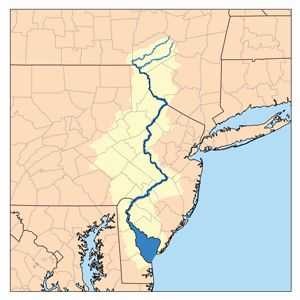Related Topics
Central Pennsylvania
"Alabama in-between," snickered James Carville, "Philadelphia, Pittsburgh, and Alabama in-between."
Headwaters of the Middle Atlantic Rivers
When Governor Keith suggested to some German wanderers that they might reach the Susquehanna River by walking eighty miles west from Kingston NY, he had probably never tried that route himself. Two mountain valleys converge toward Kingston on the west bank of the Hudson and were ideal routes for Indians to bring their furs to the Dutch trading post, later to become a whaling port. Taking the northern valley to arrive at what is now Cooperstown NY, the traveler discovers a beautiful mountain lake creates the Susquehanna River, much as Lake Geneva in Switzerland creates the Rhone, giving credence to the claim that Geneva is the most beautiful city in the world. Alternatively, taking the more southerly valley west from Kingston brings a traveler first to a mountain bowl from which several creeks run in different directions, before descending to what is now Oneonta on the Susquehanna. Just which valley the twenty-five German families actually followed in 1687 or so, is presently uncertain but either route would get you to the river after hiking about eighty miles. From either place, it is possible to float about four hundred miles downriver on a flatboat, to the famously rich topsoil of what we now call the Pennsylvania Dutch country. If you took it today it would be a terrifying ride, and in the 17th Century, it must have been much more so. First, you go south, then north, then west, then southeast, then southwest, then southeast again, as the North Branch of the Susquehanna finds openings in the mountain ranges, eventually emptying into the Chesapeake Bay four hundred miles to the south.
The reader may choose to follow that route (by automobile on roads closely paralleling the river), for which, clicking on the Philadelphia Reflections Topic called German Immigrants via New York are comments on the three hundred years of history that subsequently affected this first, founding, westward frontier. But it's still a mountainous wilderness for the most part, quite effectively dramatized in the movie How the West Was Won. The history of America was once regarded as the history of a moving frontier; the one which began here and ended up around 1900, in Arizona.

|
| Delaware River |
So focus first on the Mid-Atlantic tri-river watershed, the eighty-mile area west from Kingston NY. Some collision of ancient plate tectonics caused the North-South Appalachian mountain ridges to bend sharply at about the level of New York City, resembling a jumble of little mountains which subsequent glaciers ground down and smoothed out. The series of vertical ridges we call Appalachia more or less all bend sharply eastward at this level and the rivers consequently run in various directions, away from that center. The watershed of the Hudson runs along its banks for a few miles, the Susquehanna finds its way among the mountains eighty miles to the west, and Delaware gets snuffed out between them. When things sorted themselves, the streams had found their way into three main pathways, roughly parallel as they flowed south on their way to the sea. There's another way to look at the result. When the prevailing winds blow cold air from Canada across the Great Lakes, they pick up vast amounts of moisture which is dumped on upstate New York in huge winter snowbanks, or simply rain and fog the rest of the year. This massive rainfall system generates the water for three large river drainage systems. There's one more point of amateur geology: the advancing glaciers scraped the topsoil from the top of the land down to and over the mountain ranges and then dumped topsoil on the southern Pennsylvania counties as they receded. The German settlers of our story were seeking to get around the rocks and pebbles in order to live in eternal happiness in Lancaster County, PA. Governor Keith had somehow been told of this geography from Indian tales, and the scattered reports of white explorers confirmed it. You have to be pretty desperate to stake your family's survival on such reporting.
In any event, the settlers did give it a try, taking either the northerly or the southerly passage out of Kingston. Present hindsight suggests the southern route was shorter, but the northern route was more scenic. So scenic in fact that two prosperous residents of 18th Century Philadelphia bought up large tracts of land. Judge William Cooper of Camden (father of James Fennimore Cooper) bought 10,000 acres around Cooperstown, and William Bingham bought up a region he never visited, now called Binghamton, NY. The area is also noted for the much later construction of the main IBM calculator factory, and for the fact that I was married there, immediately spiriting the local girl back to Philadelphia where I belong.
Originally published: Thursday, October 28, 2010; most-recently modified: Tuesday, May 21, 2019
| Posted by: salma | Feb 13, 2012 10:15 PM |